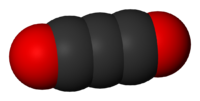คาร์บอนซับออกไซด์

| |

| |
| ชื่อ | |
|---|---|
| Preferred IUPAC name
Propa-1,2-diene-1,3-dione | |
| เลขทะเบียน | |
3D model (JSmol)
|
|
| ChEBI | |
| เคมสไปเดอร์ | |
| MeSH | Carbon+suboxide |
ผับเคม CID
|
|
| UNII | |
CompTox Dashboard (EPA)
|
|
| |
| |
| คุณสมบัติ | |
| C3O2 | |
| มวลโมเลกุล | 68.031 g·mol−1 |
| ลักษณะทางกายภาพ | แก๊สไม่มีสี |
| กลิ่น | แรง, ฉุน |
| ความหนาแน่น | 3.0 kg/m3, แก๊ส[1]
1.114 g/cm3, ของเหลว[2] |
| จุดหลอมเหลว | −111.3 องศาเซลเซียส (−168.3 องศาฟาเรนไฮต์; 161.8 เคลวิน) |
| จุดเดือด | 6.8 องศาเซลเซียส (44.2 องศาฟาเรนไฮต์; 279.9 เคลวิน) |
| ทำปฏิกิริยา | |
| ความสามารถละลายได้ | ละลายได้ใน 1,4-ไดออกเซน, อีเทอร์, ไซลีน, CS2, เตตระไฮโดรฟูแรน |
ดัชนีหักเหแสง (nD)
|
1.4538 (6 °C) |
| 0 D | |
| โครงสร้าง | |
| รอมบิก | |
| quasilinear (ขึ้นกับเฟส) | |
| อุณหเคมี | |
ความจุความร้อน (C)
|
66.99 J/mol K |
Std molar
entropy (S⦵298) |
276.1 J/mol K |
Std enthalpy of
formation (ΔfH⦵298) |
−93.6 kJ/mol |
| สารประกอบอื่นที่เกี่ยวข้องกัน | |
ออกไซด์ที่เกี่ยวข้อง
|
คาร์บอนไดออกไซด์ คาร์บอนมอนอกไซด์ ไดคาร์บอนมอนอกไซด์ |
สารประกอบที่เกี่ยวข้อง
|
คาร์บอนซับซัลไฟด์ คาร์บอนซับไนเตรต |
หากมิได้ระบุเป็นอื่น ข้อมูลข้างต้นนี้คือข้อมูลสาร ณ ภาวะมาตรฐานที่ 25 °C, 100 kPa
| |
คาร์บอนซับออกไซด์ หรือ ไตรคาร์บอนซับออกไซด์ คือปริมาณออกไซด์ของคาร์บอนที่มีอยู่ในสูตรเคมี C3O2 หรือ O=C=C=C=O ซึ่งมีพันธะคู่ต่อเนื่องสี่พันธะจึงเรียกว่า คูมูเลน เป็นหนึ่งในสมาชิกที่มีเสถียรภาพในชุดของโมเลกุลสายตรงออกโซคาร์บอน O=Cn=O ซึ่งรวมถึง คาร์บอนไดออกไซด์ (CO2) และเพนตาคาร์บอนไดออกไซด์ (C5O2)
สารเคมีนี้ถูกค้นพบใน ค.ศ. 1873 โดยเบนจามิน โบรดี โดยการควบคุมโมเลกุลคาร์บอนมอนอกไซด์ผ่านกระแสไฟฟ้า เขาอ้างว่าผลิตภัณฑ์ที่ได้เป็นส่วนหนึ่งของชุดโมเลกุลออกไซด์คาร์บอน ที่มีสูตร Cx+1Ox อย่างเช่น C2O, C3O2, C4O3, C5O4, ... และมีการระบุผลิตภัณฑ์สองโมเลกุลคือ C4O3 และ C5O4[3][4] อย่างไรก็ตามมีเพียง C3O2 ที่เป็นที่รู้จัก ในปี 1891 มาร์แซลแลง แบร์เตอโล ตั้งข้อสังเกตว่าการให้ความร้อนคาร์บอนมอนอกไซด์บริสุทธิ์ที่ประมาณ 550 °C สร้างแก๊สคาร์บอนไดออกไซด์จำนวนน้อยแต่ไม่มีร่องรอยของคาร์บอน สันนิษฐานว่าออกไซด์ที่อุดมด้วยคาร์บอนถูกสร้างขึ้นแทน ซึ่งเขาเรียกว่า "ซับ-ออกไซด์" เขาสันนิษฐานว่ามันเป็นผลิตภัณฑ์เดียวกับที่ได้จากการปล่อยประจุไฟฟ้าและเสนอว่าสูตรคือ C2O[5] ในภายหลัง อ็อทโท ดีลส์ ระบุชื่อที่เป็นแบบสารประกอบอินทรีย์คือ ไดคาร์บอนิลมีเทน และไดออกซัลลีน
โดยทั่วไปจะถูกอธิบายว่า เป็นของเหลวที่เป็นน้ำมันหรือแก๊สที่อุณหภูมิห้อง และมีกลิ่นที่ระคายเคืองอย่างยิ่ง[6]
อ้างอิง
[แก้]- ↑ "Carbon Suboxide". WebElements Periodic Table. สืบค้นเมื่อ 19 กุมภาพันธ์ 2019.
- ↑ Weast RC, Astle MJ, บ.ก. (1983). CRC Handbook of Chemistry and Physics (64th ed.). Boca Raton: CRC Press. p. B-82. ISBN 978-0-8493-0463-7.
- ↑ Brodie, B. C. (1873). "Note on the Synthesis of Marsh-Gas and Formic Acid, and on the Electric Decomposition of Carbonic Oxide" (pdf). Proceedings of the Royal Society (London). 21 (139–147): 245–247. doi:10.1098/rspl.1872.0052. JSTOR 113037.
When pure and dry carbonic oxide [=carbon monoxide] is circulated through the induction-tube, and there submitted to the action of electricity, a decomposition of the gas occurs [...] Carbonic acid [=carbon dioxide] is formed, and simultaneously with its formation a solid deposit may be observed in the induction-tube. This deposit appears as a transparent film of a red-brown color, lining the walls of the tube. It is perfectly soluble in water, which is strongly colored by it. The solution has an intensely acid reaction. The solid deposit, in the dry condition before it has been in contact with the water, is an oxide of carbon.
- ↑ Brodie, B. C. (1873). "Ueber eine Synthese von Sumpfgas und Ameisensäure und die electrische Zersetzung des Kohlenoxyds". Annalen der Chemie. 169 (1–2): 270–271. doi:10.1002/jlac.18731690119.
- ↑ Berthelot, M. (1891). "Action de la chaleur sur l'oxyde de carbone". Annales de Chimie et de Physique. 6 (24): 126–132.
- ↑ Reyerson LH, Kobe K (1930). "Carbon Suboxide". Chem. Rev. 7 (4): 479–492. doi:10.1021/cr60028a002.
แหล่งข้อมูลอื่น
[แก้]- WebElements page on compound's properties
- "Katalog der Deutschen Nationalbibliothek" [Catalog of the German National Library]. German National Library | dnb.de (ภาษาเยอรมัน).
